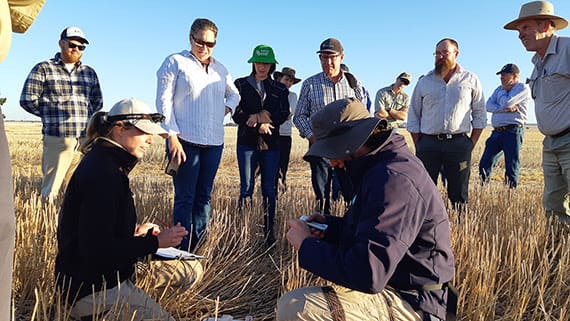
CSIRO researchers with members of the National Mouse Group visiting a field site. Photo: CSIRO
GRAIN growers across Australia are being urged to check paddocks for mouse numbers and record mouse activity as part of a national campaign aimed at early detection and effective control ahead of this year’s winter crop.
Concerns about mouse numbers were front of mind at the latest meeting of the National Mouse Group (NMG).
A Grains Research and Development Corporation investment, the NMG includes specialist researchers, growers, advisers and industry stakeholders, and has been formed to co-ordinate action to counter mouse plagues.
CSIRO mouse researcher Steve Henry is encouraging growers to monitor and log mouse activity this season through the free MouseAlert website, via X (formerly Twitter) using @MouseAlert or through the FeralScan Pest Mapping app.
MouseAlert is a free online tool that allows growers to record and view mouse activity in their area, and aid collective NMG efforts to track and manage mouse populations effectively.
Mr Henry said monitoring also had a key role in providing organisations such as CSIRO with a more comprehensive understanding of mouse activity.
“We are urging growers to get out of their utes and check their paddocks,” Mr Henry said.
“Even if you think mouse numbers may be low, get out, walk through paddocks and look closely for any signs of current mouse activity.
“High stubble loads can hide the signs of mouse activity.
Mr Henry said high mouse numbers could have “devastating impacts” on crops being sown in coming months, and that regular monitoring and early identification of mouse infestations was essential.
If left unchecked, a mouse population can quickly escalate and result in crop losses, reduced yields, and increased costs associated with pest control measures.
In addition to eating crops, mice can also damage infrastructure such as irrigation systems and farm buildings.
“This year, we are seeing localised and patchy mouse activity.
“In some areas, good summer rains could lead to increased mouse numbers, but conversely, flood events may have helped to keep mouse populations low.
“The key message is to monitor.”
Growers who do record high numbers are advised to apply control measures when background food is at its lowest, which is generally at sowing, to give mice the best chance of finding and eating the bait, and to protect germinating crops.
Growers should also be aware that the emergency permit for ZnP50 expired at the at the end of December 2023, so 25g/kg zinc phosphide baits (ZnP25) are currently the only registered bait available.
Zinc phosphide bait must be spread according to the label rate of one kilogram per hectare.
Growers are reminded, as with the use of any registered product or product under permit, to report unexpected outcomes, including lack of efficacy or off-target effects, directly to the Australian Pesticides and Veterinary Medicines Authority.
While correct use of bait products is critical, GRDC pest manager Leigh Nelson said chemical control was only part of the solution.
“It’s not just about putting the bait out and hoping for the best, growers need to continue checking paddocks, assess the situation and decide if additional actions are necessary,” Dr Nelson said.
“Safety is also a key concern, particularly when handling bait.
“Growers should take care when transferring bait from bulk bags to spreaders to avoid spills and ensure the safety of all involved.”
For more information go to the GRDC Mouse Management page.
Source: GRDC



HAVE YOUR SAY